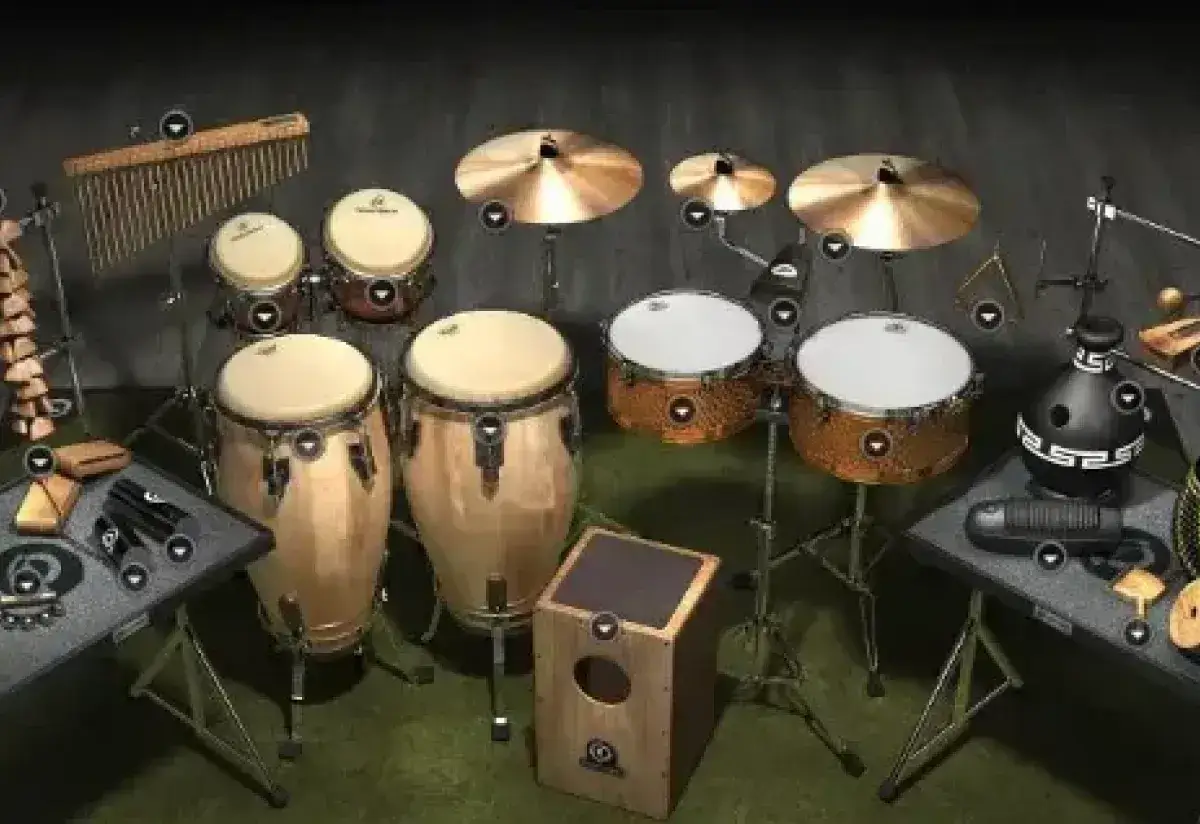Bongos Overview
Bongos are the heartbeat of Afro-Cuban music, merging two distinct and traditional drumming cultures. They are one of the most recognizable hand drums in the world and are an essential part of Latin and jazz music. The bongos consist of two small conical drums that are attached to one another by a wooden block or metal bridge. One end of each bongo drum is covered by a stretched membrane and the other end is left open. One of the drums, the hembra (meaning female) is larger than the other, the macho (meaning male).
Bongo shells are traditionally made of oak wood with drum heads made of animal skin (usually rawhide). Modern bongos are made of many different types of wood and use either animal or synthetic skin. The drums also have metal hardware consisting of lugs, tuning rings, the bearing edge, and the center bridge. The bongos are always played together, never separately, and the high-pitched tone lends itself to syncopated rhythms. They’re open drums and are therefore more susceptible to drying out. The membranes must be maintained with drum oils that keep the skin from cracking or splitting.
Bongo players are called bongoceros, and they position the drums between crossed legs while sitting or attached to a stand. The bongos can be placed in any position but typically the hembra (larger) drum is placed on the dominant side of the player. Bongo strokes are made with the pads of the fingertips, thumbs, and heels of the hand. The knuckles are never used to strike the drums, partially because it makes an undesirable tone and partially because it does damage to the player’s hand.
Bongo drum heads vary in size but both drums are typically sized between 15 and 22 cm in diameter. There are also children’s size bongos with a diameter of around 12 cm. It’s important to know these measurements before buying bongo drums online. The bongos are also a popular hobby instrument because of their small size and popularity. Even some celebrities have learned to play bongos for fun, like James Dean, Marlon Brando, and Matthew McConaughey.
History of Bongo Drums
The Bongos have African-Cuban roots, the result of thousands of slaves brought to Cuba from the Bantu-speaking Congo region of Africa during the 17th and 18th centuries. When slavery ended in Cuba at the end of the 19th century, African and Latin drumming merged to create several hybrid percussion instruments including the bongos and the congas.
The bongo instrument is similar to many traditional African drums but the playing style originated in the eastern region of Cuba, in the Oriente Province, as folk instruments. Two distinct musical styles emerged in this region during the 19th century that brought popularity to the bongos, Son and Changüí. These two styles are the basis for all bongo playing and are still used today.
In the early 1900s, the bongos made their way to the western region of Cuba, including Havana, and began to be used in more diverse musical genres. Son Cubano folk tradition also inspired the big band movement, which gained international popularity. When Latin music, particularly Cuban music, began influencing jazz in the 1930s, the bongos made their way to the United States and became an essential part of American jazz.
Types of Bongos
Exact dimensions of bongos vary slightly by manufacturer but remain largely the same. More modern versions of the instrument have been made of metal or fiberglass but these are less popular than the wooden version, which tends to have a warmer tone.
Traditional bongos used in Afro-Cuban folk music are still made today. Changüí bongos, also known as bongó de monte, are larger and tuned lower than modern bongos. These drums are also made traditionally with tacked-on drum heads instead of the modern tuning heads.
Compact bongos are a shell-less version of bongos that can be integrated into modern drum kits or played on their own. The aluminum alloy base is lightweight, compact, and can be played with sticks or hands. The drum heads support animal and synthetic skins and some percussionists say the sound projects the same as wooden bongos.
Some electronic drum kits include settings that approximate the sound of bongos and there are a few electric drum pads that are made to resemble the bongos, as well. These are great options for those that prefer to play quietly, as they can be heard through headphones. Small, inexpensive electronic bongos are made for children but they typically do not carry the tone of traditional bongos.
Playing Techniques
There are four standard strokes used in bongo playing.
- The mute tone is made by striking the drum with four fingers while holding the base of those fingers against the skin, which muffles the tone.
- The open tone is made by striking the rim of the head with four fingers held together.
- Slap tone is made by curving the fingers while striking the middle of the drum head, allowing the palm to simultaneously strike the edge. The slap stroke makes a popping sound.
- Heel-toe is made by rocking the heel of the palm to the tip of the fingers back and forth, striking the drum alternately each time. The hand remains in contact with the head during this stroke, which sounds similar to a drum roll.
Several rhythm patterns have been created specifically for the bongos, like taals. The most popular is the 'Martillo', or ‘hammer' style. This pattern creates a sequence of eight distinct sounds, creating a complex accompaniment to any piece of music. Although there are standard rhythms, the bongo is also a very popular and traditional solo instrument. The versatility of sound production in these small drums makes them ideal for rhythmic improvisation.
In some contemporary world music, the bongos are mounted on a stand and played with drumsticks as an accent to other percussion instruments. Their high pitch lends itself well to syncopated rhythms, the desired accent in several musical genres. The bongos are also a traditional accompaniment to the deeper tone of the conga drums.
Bongos Mechanics
Original bongos were unpitched percussion instruments with nailed-on drum heads. Traditional bongoceros were able to change the pitch by either moistening the skin with water or heating it to remove moisture. Moistened drum heads lower the pitch while heated drum heads allow the skin to vibrate faster, producing a higher pitch. These methods were imprecise and were not used during a performance, only before playing to achieve the desired tone.
Modern bongoceros have much more control over the pitch of their instrument. Since the mid-20th century, bongos have had tuning hardware attached to them. The drums use tuning lugs attached to hooks on the tuning ring around the rim of the drum head. The tuning lugs are tightened or loosened using a tuning wrench and tuning oil. Because each drum has multiple tuning lugs, it’s important to maintain the same tension for each one.
Generally, the macho head is tuned to a much higher pitch than the hembra, meaning the drum head is stretched very tight. The hembra is then tuned to a much lower pitch, typically one octave below the macho. It’s very important to detune bongos (release tension) after playing or practicing. This is because environmental changes, like the weather, can have a dramatic effect on drum heads, causing them to warp or split. (Synthetic skins do not have to be retuned, only animal skins.)
Notable Bongo Players
There are countless talented bongo players in history and the present day. Below are some of the most well-known Bongos players from around the world.
- Art ‘Turk’ Burton
- Bobbye hall
- Candido Camero
- Chino Cruz de Jesus
- Frank Colón
- Johnny ‘Dandy’ Rodriguez
- José Mangual Jr.
- Kevin Ricard
- Lenny Castro
- Michito Sanchez
- Monojit Datta
- Natasha Rogers
- Orlando ‘Rolito’ Soto
- Paoli Mejias
- Preson Epps
- Roberto Roena
- Roberto Sierra
- Trilok Gurtu







